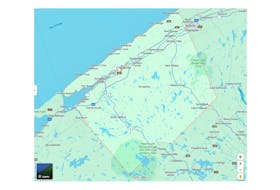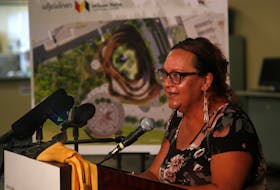The Nova Scotia government says it is getting close to fully applying the new forest practices guide but a local environmentalist counters that integrated Crown land planning must go beyond forestry.
“The wider issue is that this is being done in isolation, as if the only consideration for Crown land use is where will forestry take place and how much,” said Raymond Plourde, the senior wilderness co-ordinator with Ecology Action Centre, a Nova Scotia environmental organization.
“What’s not being considered is the commitment for 20 per cent protection by 2030 and those lands need to also be planned for and also the government released requests for proposals for wind farm developments without any guidance with regard to where those wind farms should or should not be located.”
The PC government passed the Environmental Goals and Climate Change Reduction Act in November, committing to preserve at least 20 per cent of the total land and water mass in the province.
In February, the province issued a request for proposals for wind and solar energy projects that will supply 10 per cent of the province’s electricity, with the expectation of selecting up to five projects.
“What we’ve been saying with government is that you need to do an integrated Crown land use process that factors all of these things,” Plourde said. “Otherwise, this Lahey model may be applied to all Crown lands as if there are no other uses or considerations.”

The guide referenced in the government announcement is the Silvicultural Guide for the Ecological Matrix that applies to Acadian forest on Crown land and is being phased in gradually.
By June 1, the government says the majority of practices in the guide will be required.
“We are moving ahead with a fundamental shift in how forestry is done in this province, placing a higher priority on biodiversity and protecting healthy ecosystems within our provincial forests,” said Tory Rushton, minister of natural resources and renewables.
“We’re supporting that shift through broad-based training for our staff and forestry operators and projects that help private woodlot owners explore how they can adopt ecological forestry.”
The guide was revised in December 2018 to align with the ecological forestry practices described by Prof. William Lahey in his August 2018 independent review of forest practices in the province.

The Lahey report called for a triad model in which forestry would be prohibited on a portion of Crown land, lower-impact forestry would be permitted on another mixed forest portion of land, and a third portion, the smallest of the triad, would be designated for high-production forestry.
The silviculture guide deals only with the mixed forest portion of the triad and, since Feb. 1, the department has required that new harvest plan proposals follow most of the practices in the new guide.
The requirement also applies to proposals that were submitted before Feb. 1 but not approved by that date. These harvest proposals now reflect the latest requirements when they are posted on the Harvest Plan Map viewer for public consultation.
Effective June 1, the requirement to follow practices in the new guide will be extended to most harvest plans that had been approved using previous guidelines. In the few cases where meeting that timeframe is not possible, licensees must work with the department to transition their harvest plans as quickly as possible.

Some harvest plans that were approved under old guidelines will be grandfathered. The original approval can be followed to completion, as of June 1, if the licensee is actively harvesting a block or if the block has 10 hectares or less remaining to be harvested.
Plourde said the government announcement is positive and he is not overly concerned about the grandfathering provision.
“The grandfathering isn’t ideal but it’s relatively minor and will come to an end fairly quickly,” he said. “The direction is to fairly quickly get everybody into compliance.
“The new government, after eight months in office, is finally starting to implement the Lahey report and one of the most important elements of the Lahey report. We lament the four years of delay, which has meant four more years of aggressive cutting, including clearcutting, under the old rules.”
Plourde said what is of concern is the significant increase in the percentage of Crown land being harvested in comparison with private land harvesting over the past 25 years.
“The industry is relying more and more and more on Crown land for their wood supply and less and less on private lands,” Plourde said.
Crown land makes up about 34 per cent of all Nova Scotia lands, Plourde said, but a recent report identifies that only nine per cent of harvested wood came from Crown land in 1997, compared with 30 per cent from Crown land in 2017 and 25 per cent in 2019.
The Natural Resources and Renewables Department says the next steps in fully implementing the new guide includes more training for forestry industry workers and developing a software solution to translate proposal data into final harvest plans.
The department said in a release that work is also underway to define how and where high production forestry can take place on Crown lands, the smallest of the three ecological forestry zones recommended by Lahey.
“For us, with regard to implementing Lahey, our position has been firm from the beginning,” Plourde said. “ No more than 10 per cent of forested Crown land should be considered for high-production forestry and none of it should involve clearcutting natural, mixed forest, which should go in the ecological matrix allotment. Crown lands used for high-production forestry should only take place on existing plantations that have been established over the decades and no new clearing of natural forests should be done to create new plantations.”









